The Mystery Pub Is Revealed At Last
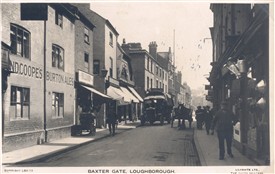
The Rose and Crown, 8 Baxtergate, Loughborough circa 1914
By Kind Permission, Loughborough Local Studies Volunteer Group, Local Studies, Loughborough Library, Leicestershire County Council
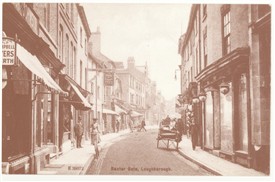
Postcard of Baxtergate Loughborough, Leicestershire
By Kind Permission, Local Studies Volunteer Group, Loughborough Library, Leicestershire County Council
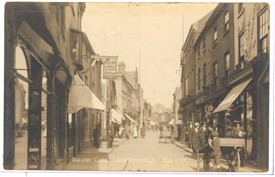
Postcard of Baxtergate, Loughborough. The distinctive sign for the Rose and Crown can be seen on the left hand side
By Kind Permission, Local Studies Volunteer Group, Loughborough Library, Leicestershire County Council
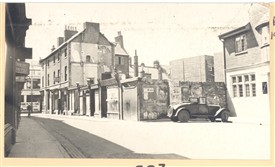
The new Rose and Crown can be seen of the right hand side. Buildings to the left are being demolished for road widening
By Kind Permission, Local Studies Volunteer Group, Loughborough Library, Leicestershire County Council
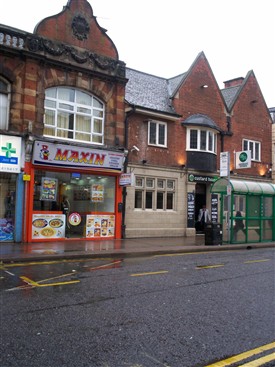
The Rose and Crown today, rebuilt in 1924 and now called the Custard Lounge
Anne Coyne
Read on to find out where it was!
By Anne Coyne
You may remember the photo of this pub that was published on the “Mystery photos of Newark” page in 2010. The licensee’s name was Herbert Dobney and we believe the name to be the Crown but this is not known for sure.
Well a few more clues have come to light, so I am looking for help from all local history detectives to finally solve this puzzle. It would be grand if you could use your knowledge of local history, family history, building styles and interpretation or even history of clothing to unravel the mystery. I wonder which discipline will reveal the answer or will it be a combined effort?
CARTERGATE AND SWINESHEAD
The Newark Herald Archives from 1915, which can be viewed on microfilm at Newark Library, reveal that there were two important Dobney brothers in Newark at the time. The first was F.R Dobney, who had a music business in the market place, but was also a property agent, the second G.E Dobney was a builder and an undertaker. An article entitled New Building for Cartergate, shows that the brothers had submitted plans to build a new building on the site of the late Black Bull Inn.
Newspaper articles and 1861 census search show that the brothers were from Swineshead, Lincs. I have consulted my history book on Swineshead, and no pub called the Crown was listed, so I sent an email to the author, Pam Southworth, who writes.
“Yes there was a pub called The Rose & Crown, later renamed The Elephant & Castle. It stood in South Street and the building is still there although it is now a private house. I didn't know this fact when I wrote the book about Swineshead's history but learned this later.”
ELDON STREET
Eldon Street was just off Albert Street, where the Brewery development is now.
The 1897-1898 Directory for Newark and District gives one Richard Dobney, a greengrocer, living at 19 Eldon St. In an earlier Directory he is listed as a brewer’s labourer. Census results give his name as Richard Daubney.
1844 Directory shows one William Marriott having a Brewhouse on Eldon Street and the 1881 Census shows a John Marriott, a brewer’s labourer living on Eldon St. The 1861 census shows one William Key, bookbinder and brewhouse keeper, living at 7 Eldon Street.
Guy Hemingway’s history of Newark Inns lists a Crystal Palace in Eldon Street in 1865. This is confirmed by the Newark Advertiser from Wednesday 7th June 1865 which lists the beerhouse as follows;
To be Let, THE CRYSTAL PALACE, Eldon St, Newark. Satisfactory reasons for leaving the same – apply on premises.
HEMINGWAY’S HISTORY OF NEWARK INNS
Other pubs by the name of the Crown are also listed at the following locations in Newark.
65 Appletongate
55 Tenter Buildings
Castlegate
An early directory for Newark lists a Crown pub on Cartergate as well.
DISTRIBUTION OF HOLE’S PUBS
The history of Hole’s Brewery that is available in Newark Library's Local Studies collection, states that the Brewery had pubs ranging from Doncaster and Grimsby in the North to Spalding and Stamford in the South.
So who was Herbert Dobney and did he have any connection to Newark at all?
1881-1901 census results shows persons by the name of Herbert Dobney living at the following places, Oakham Rutland, Melton Mowbray, Leics, Loughborough, and St Margaret’s Leicester. There was also a Herbert Dobney born at Spalding Lincs in 1855.
There is a Crown Inn at both Oakham and Melton Mowbray, but both are old coaching inns and do not bear any resemblance to our picture.
BUILDING STYLE
I would consider the building to be Georgian in age and it looks similar to many buildings in Newark. The ground floor may be converted into a shop front or private house now, so will look completely different. It is likely that the roof line remains the same if the building is still standing. It has two square windows in the top storey but two slightly arched windows on the first floor. There is also a butcher’s shop next door in the photo.
The building looks like that those of a small town as opposed to a village.
HISTORY OF CLOTHES
Can anyone pinpoint the exact time period the photo was taken from the clothes please? I would say Edwardian or early 1900s.
UPDATE - THE PUB IS FINALLY REVEALED
After six months of painstaking research the mystery pub was finally located. The solution involved a mixture of investigative research, logic, personality theory, inspiration, intuition and synchronicity and determination.
There were four main clues to the whereabouts of the pub. These were the connections to the owner of the photo, the fact that the pub was one of, Holes & Co Brewery of Newark, the age of the photo and finally the Licensee Herbert Dobney.
It was already known that James Hole & Co had a range of pubs in the East Midlands and these ranged from Doncaster and Grimsby in the North to Spalding and Stamford in the South. It was decided that the pub must lie within this geographic area.
The owner of the photo had no knowledge of anyone on the photo and certainly no knowledge of one Herbert Dobney. A brief research into the owner’s family history revealed no obvious connection either.
Looking at the style of dress and pub adornments such as the shutters and sign, it was believed that the photo dated from the very early 1900s. A search for the name Dobney on the 1901 census on Ancestry revealed four main clusters of the name within the East Midlands. These were Leicestershire, Rutland, Nottingham in Nottinghamshire and Spalding registration district in Lincolnshire. The Dobney brothers who lived at Newark were from Swineshead which is not far from Spalding so a trip was made to Lincolnshire Archives to search through the directories. Unfortunately this search proved fruitless .
I thought that a person who had their own business like Herbert Dobney from the photo, must have had drive and determination so I decided to look at the 1901 census within the East Midlands for a Herbert Dobney who possessed these characteristics. The results of this search are given below.
1) Herbert Dobney aged 46, born Wymondham Leics, was a Boot Shop Manager. His son, another Herbert Dobney, was 19 and a machine fitter. His wife Elizabeth was 38, and they lived at 9 Market Place Loughborough.
2) Herbert Dobney aged 18 was a Boot and Shoe Finisher and he lived with his father Thomas who was a Stone Mason. They lived on Braunston Road, Oakham in Rutland.
3) On the 1881 census there was Frank Dobney who was a Blacksmith and his son Herbert was 4. They lived at 6 Soho Street Melton Mowbray, Leics.
Out of the three, Herbert Dobney the Boot Shop Manager seemed the most likely person, so I researched into his background more carefully.
In 1891 Herbert Dobney lived at 143 High Street, Stourbridge in Worcestershire and in 1911, at 11 Market Square, Witney in Oxfordshire.
On all three census forms he was described as a Boot Shop Manager so I consulted the online directories website available from Leicester University. The Stourbridge and the Loughborough premises were both confirmed to be Freeman Hardy and Willis shops. The fact that this Herbert Dobney had moved around the country as a shop manager convinced me that he was ambitious enough to be licensee of a pub. The remaining question to be answered was where was the pub?
Loughborough was one of the obvious locations as the pub had to be in a town or city not a village. I could not find the building on a day trip to Loughborough and it was obvious that some of the old buildings had been replaced in the early 1900s during road widening.
In 1881 Herbert Dobney was a shoe clicker and was boarding at 113 Humberstone Road, Leicester. Also living at this address was Mary Ann Watchorn, the woman who was to become his first wife, and Harriet Watchorn nee Dobney. Both of these woman were born at Coston in Leicestershire. From here I visited Leicester Records Office to look at the company records for Freeman Hardy and Willis and to look at the Leicester directories to see if there was a Herbert Dobney running a pub before 1901.
This further research also proved fruitless but whilst on a visit to Leicester Central Library a chance find was to give the breakthrough. As in so many cases it was the work of another local historian that revealed the location. Bill Wells was the author of a book about old alehouses, beerhouses and public houses of Loughborough.
There was a picture of the old Rose and Crown at 8 Baxtergate, Loughborough together with a new Rose and Crown that was rebuilt in 1924. Interestingly enough the brewery on the photograph was Ind Coope’s Ales at Burton and not Holes brewery at Newark.
I then went to consult the Electoral Registers and Licensee records for Loughborough at Leicester Records Office.
The 1901 Electoral Registers show Thomas Mills living at 8 Baxter Gate and Herbert Dobney at Freeman Hardy and Willis (9 Market Place).
1902 Electoral Register shows Thomas Mills living at the George Yard, Market Place, Loughborough and Herbert Dobney at the Rose and Crown, 8 Baxtergate, Loughborough. Someone, called John Edwin Ayre is at 9 Market Place (FHW).
The Licensee records and an advert from the Loughborough Almanac 1902 give the final picture.
In 1898 and 1899 Jas Hole of Newark on Trent were owners of the pubs called the White Lion and the Cherry Tree in Loughborough and already had some presence in the town before taking on the Rose and Crown on Baxtergate.
The Rose and Crown is recorded as belonging to John V Stevens and then a Robert Stevens Crane from 1903. The building never actually belonged to Jas Hole of Newark on Trent. Herbert Dobney takes over from Thomas Mills on the 14th August 1901 and is licensee until 3rd August 1904 when he is replaced by Henry Siddons.
In the almanac from 1902 there is an advert for T Mills at the George Vaults, George Yard, Market Place, Loughborough. It states he had over 14 years experience at the Rose and Crown, therefore when Thomas Mills moved to another pub this gave Jas Hole & Co the chance to take the license and for Herbert Dobney to leave Freeman Hardy and Willis to become licensee.
Herbert Dobney only stayed for 3 years between 1901 and 1904, however this period saw a general slump in the beer trade, so perhaps there was a better future as a Boot Shop Manager once more.
If you look at the photograph of Baxtergate this could easily be a scene from a Newark Street. How the photograph came to Newark and what its connection is to the owner, still remains a mystery.
Anne Coyne
SOURCES AND ACKNOWLEDGEMENTS
All the books and Newspaper archives used in the investigation are available in the Local Studies collection at Newark Library.
Census Information is available on www.ancestry.co.uk at any Nottinghamshire Library.
Court Records of Petty Sessions were also consulted at Nottinghamshire Archives.
Ye Olde Alehouses, Beerhouses, Hotels, Inns, Public House, Taverns, and Alcoholic Anecdotes of Loughborough throughout the Ages. Author Bill Wells. November 2002.
Local Studies Volunteer Group, Loughborough Library, Granby Street, Loughborough Leics, LE11 3DZ, Leicestershire Country Council.
Leicester Central Library, Leicester Central Library, Bishop Street, Town Hall Square, LE1 6AA, Leicester City Council
Record Office for Leicestershire, Leicester and Rutland, Long Street, Wigston Magna, Leicester, LE18 2AH, Leicestershire County Council